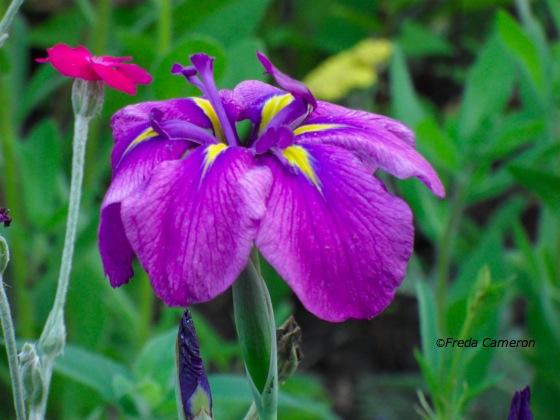 |
| Iris ensata. June 2012 |
Although I always dread the fall chore of digging up big clumps of Japanese iris every three years, I must admit that doing so opens the opportunity to try different vignettes.
The purple Japanese iris (tag long gone and so it is unknown) is a great bloomer. With my last division of this iris, I planted it graduated—or staggered—up a slope rather than on the same level. My logic was that each clump grows quickly and by planting each divided piece up the slope instead of grouped on the same level, I could hopefully extend the number of years before needing to divide again.
Was the resulting design a "staggering" achievement or defeat?
 |
| Overhead view of the "staggered" planting. |
The staggered planting adds to the layers of foliage, flowers and even seed pods as the garden fluxes with different bloom times of the surrounding plants. In such a large garden, I have to rely upon foliage that looks good throughout the growing season.
The monarda and echinacea foliage provide wider leaves, while the Japanese blood grass foliage is pointed and echoes the deeper red from the spirea. The frilly foliage of spirea and ageratum keeps the mass of from looking the same with the gold and bright green colors.
This is a large section of garden, so there are many more perennial players to the sides as well as up and down the slope. The month of June, everything changes so quickly. The blooms of Japanese iris last only a short time, but the long, pointed foliage can be easily blended into the garden.
If you want to grow iris ensata (Japanese iris), the perennials are suitable for zones 4-9 in mostly full sun with moist, acidic soil. Deer will occasionally pick the blooms, but not bother with the foliage. The rabbit will sometimes eat the points of the foliage when it first emerges in spring. Neither has damaged the plants enough to discourage me from using the irises in the deer resistant meadow garden or the gravel garden.
 |
| Stepping back from the nearest-companions from the left view. Evening light casts a blue tone. |
 |
| After the iris blooms are gone (right-side view), the foliage blends into the deer resistant meadow garden. Full sun casts amber light. |
| Words and photos by Freda Cameron, Defining Your Home, Garden and Travel. Deer and rabbit resistance varies based upon the animal population and availability of food. All company or product or patented names mentioned are registered trademarks, copyrights, or patents owned by those respective companies or persons. |




